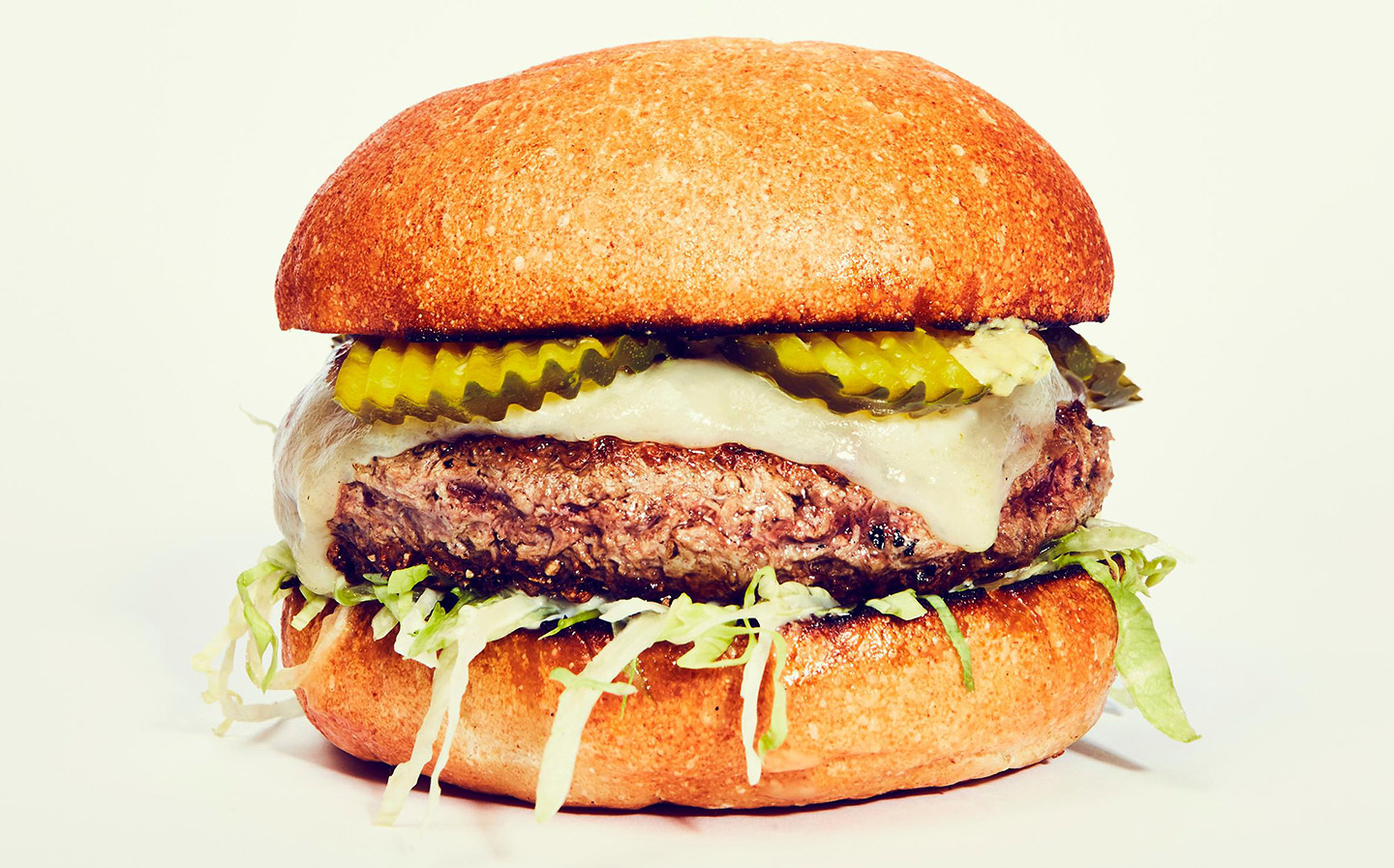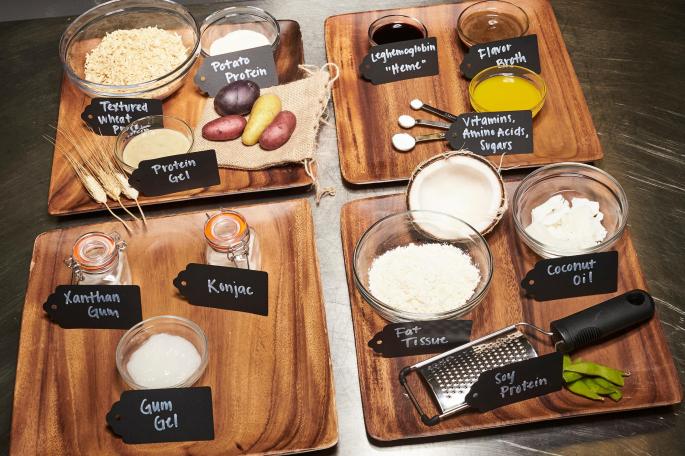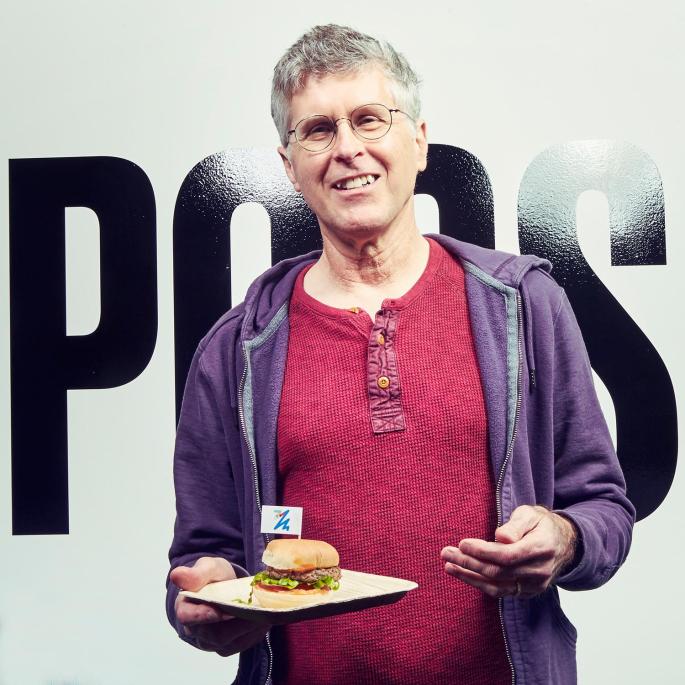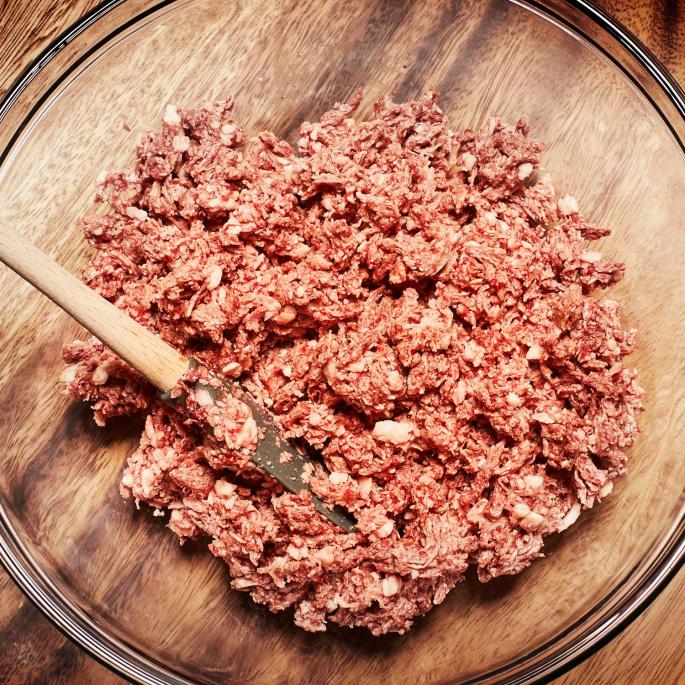Can the meat-free Impossible burger save the world?
Meat is one of the biggest causes of greenhouse gases. Hence Bill Gates and Google’s latest big idea — a meat-free burger made in a laboratory from plants, but which bleeds and sizzles. Now it’s coming to Britain. Nick Rufford & Jeremy Clarkson tuck in.
Above: Jeremy Clarkson takes the Impossible burger challenge in our exclusive video
THERE WAS definitely something odd about the burger van. For one thing, it was parked only outside building-supplies shops. For another, it carried no markings to show who it belonged to. This should have prompted questions, but as it was handing out free burgers to grateful construction workers, stopping to pick up tools and materials, none were asked.
In fact, the van was carrying out undercover research for Impossible Foods, a Silicon Valley-based bioengineering company. The burgers were made not from beef, but from protein and synthetic blood derived from plants. The “stealth” van was unmarked because the company didn’t want to arouse curiosity — or give away a closely guarded plan to disrupt the world’s $1.5tn meat industry.

For Bill Gates, founder of Microsoft, Larry Page of Google and Li Ka-shing, the Hong Kong-based billionaire, the project’s backers, the stakes are high — or possibly steaks.
Before showing its hand, the company wanted to test the product on hardcore meat eaters — and they don’t come much more hardcore than ironworkers, pipefitters and welders — hence the location of the van in American cities. If these people could be persuaded to switch from eating meat, then millions of other Americans could, too. To a man (and woman), the workers believed that the plump, meaty-tasting burgers were made from beef. Some even claimed they could tell it was from grass-fed cattle.
Browse NEW or USED cars for sale
Like other Silicon Valley ventures, the idea was based on the principle of “disintermediation” — removing the middle man — or, in this case, the middle cow. Why use animals to convert plant protein to meat when it could be done in the lab more cheaply and in ways that are kinder to animals and to the planet? Producing meat had, for decades, remained stubbornly low-tech — and expensive. Livestock needs huge amounts of land and water, and produces huge amounts of greenhouse gas. Could Impossible Foods do for meat what Amazon had for book sales, or Apple for music, by making a substitute that was cheaper and, in this case, less polluting?
To Gates, who gave up running Microsoft to tackle global problems, the commercial and environmental arguments were self-evident. As tens of millions of people in the developing world moved into the middle classes, demand for meat would reach unsustainable levels. “The richer the world gets, the more meat it eats; the more meat it eats, the bigger the threat to the planet,” Gates said. “Clearing forests to make more farmland contributes to climate change, as do the greenhouse gases produced by all those animals.”

Animal-free zone: the burger’s ingredients, displayed at the HQ of Impossible Foods in Silicon Valley
CODY PICKENS
The burger is so far sold at 11 restaurants in LA, San Francisco and New York (though not through supermarkets), with promising results. Sir Paul McCartney, a longtime campaigner for vegetarianism, and Sir Mick Jagger are among those who have been served it at Crossroads Kitchen, a trendy LA restaurant that caters for some of the world’s fussiest diners.
Both rock stars were reportedly impressed. With nearly $200m of venture capital, Impossible Foods is starting work on a new plant in Oakland, California, to produce enough meat for 4m burgers a month using industrial quantities of blood made from “haem”, a key molecule in haemoglobin, without slaughtering a single animal. Instead, the blood is produced by genetically engineered yeast. Some of the burgers will be coming to Britain. A restaurant chain with branches in the UK is in discussions to put them on its menu, and more are expected to follow across Europe. And because it cuts out the middle cow, the company claims it will be able to mass-produce its burgers more cheaply than the meat variety. Not bad for a company that started with a chance remark.
The popular image of Silicon Valley is that it is a place where inventions are hatched by computer geeks in bedrooms or garages, living on beer and pizza. It’s refreshing, then, that Patrick “Doc” Brown fits more the stereotype of the eccentric inventor.
His shock of grey hair used to prompt comparisons with his Back to the Future namesake. We meet at his laboratory in Redwood City, near Palo Alto. For two decades he was a professor of biochemistry at Stanford University, with a special interest in livestock farming and its problems. Then, in 2009, aged 54, he had a lightbulb moment.
“It’s like the iPhone. The burger tastes fantastic, but we’ll make a next generation that will be even better”
“A friend mentioned to me that if you could make a burger that McDonald’s would serve instead of a burger from a cow, then that would be the fastest way to solve the problem. It was a throwaway comment, but I realised that was exactly it. And because of my scientific background I knew it was completely doable. I found to my surprise that no one was treating it as a solvable problem. I think people just figured we have this insanely destructive system and it’s just never going to go away. They thought, ‘Bummer, but there you are.’ ”
The first phase of Brown’s plan, he confesses, was so simple it bordered on the naive. “To test out my idea, I went to a little hill behind my house and started digging up clover plants. It really was as ridiculous as it sounds. Clover roots contain a high level of a protein that is virtually identical to the haem protein in muscle tissue. I dissected them off with a razor blade then blended them up just to see what I could extract. I was just poking around, feasibility-testing some ideas. I got to a point where, though I didn’t have much data, I’d enough to go and talk to some venture-capital companies — of which there are a ridiculous number in Silicon Valley — and hit them for some money.”
With a sales pitch that Brown says, in hindsight, didn’t deserve to succeed, he raised $9m. “I talked to three different venture firms. In each case I gave a pitch that a scientist who had no business experience would give, but they were all willing to invest very quickly.”
After laboratory trials, big investors quickly arrived, including the GGs: Gates and Google. Brown found himself the accidental CEO of a $200m company. He has since turned down the offer of a $300m buyout. Apart from a haircut, his lifestyle is unchanged. He drives a Nissan and lives in the same modest flat on Stanford’s university campus, close to his laboratory, but now he has 140 staff, including 80 eager young scientists.

Don’t have a cow, man: the Impossible burger’s creator, Patrick Brown, a former professor of biochemistry at Stanford University
CODY PICKENS
Rachel Konrad came from Tesla to help run Impossible Foods (so-called because of the challenge it has taken on). “For eight years I had been selling electric cars to people so that they could reduce their carbon footprint. Yet the easiest thing you can do [to reduce that footprint] is to change what you eat. I realised that greenhouse gases from the meat industry dwarf all the CO2 produced by cars: in fact, more than all transport — vehicles, aircraft, ships — put together.”
Chris Davis, a British-born, Oxford-trained biotechnologist, is the company’s chief scientist. His job is to engineer a burger that matches exactly the taste, texture and aroma of its animal-derived counterpart. In his lab, Davis is working on “sizzle” — the way the burger reacts to cooking — and mouth-coating: the aftertaste that is crucial to meateaters’ satisfaction.
Meat samples are fed through a mass spectrometer so they can be “reverse engineered”. Human “noses’” — experts in food smells and taste — help identify what makes the aroma and flavour distinctive. There have been some surprises. Alongside “buttery” and “burnt” were “skunk” and “smelly diaper”.
Then the taste, texture and, this being California, the BBQ-ing properties are replicated with plant ingredients. Davis uses fibre from wheat and potatoes as a substitute for muscle fibre; coconut oil in place of animal fat; konjac (an east Asian plant) instead of gelatin. The result is a burger he says has more protein than the real thing, but with less fat and no cholesterol. With a nod to software updates, each improved generation of burger is named after a bird species (the latest version is Niltava, or flycatcher).
“It’s like the iPhone,” Davis says. “The burger tastes fantastic, but we’ll make a next generation that will be even better because it has better proteins, better raw materials.”
The company has proved it can create other types of meat, including pork and chicken, but to avoid overreaching itself, it is restricting itself to beef, and specifically the ground beef used in burgers. One reason is that burger meat is consumed in huge quantities — at least ½m tons a year are bought by McDonald’s alone (whose burgers are 100% beef) — offering a potentially huge market for a substitute.
Another reason is that, compared to many burgers served in fast-food restaurants, the Impossible burger looks like a wholesome alternative. Even in Britain, where food laws are tight, burger ingredients often include fillers and binders as well as mechanically recovered meat, made by treating scraps left on animal carcasses with chemicals to get rid of bacteria (unpalatably dubbed “pink slime” by the industry). Problems such as the horsemeat debacle four years ago, which began when a Tesco burger was found to contain nearly 30% horsemeat, haven’t helped the animal burger’s reputation.
Will some customers be put off by the fact that the Impossible burger is bioengineered? Konrad points out that the genetically engineered yeast used to make the haem doesn’t end up in the product — though it’s harmless, in any case. “It’s delicious and nutritious,” she insists. If it all sounds a little evangelistic, it is. The company has big ambitions — can it succeed? With only a handful of restaurants selling the burger, the critics haven’t had a chance yet to get their teeth into it, but they almost certainly will.
Browse NEW or USED cars for sale
The strongest opposition Brown is likely to face is not from restaurants (which can see the attraction of selling “meat” to vegetarians), but from the livestock industry. The United States Cattlemen’s Association is as protective of farmers as the National Rifle Association is of gun owners. It covers all 50 states and has lobbyists in Washington, as well as supporting local contests to find America’s best-tasting beefburger.
Jess Peterson is the straight-talking executive vice-president. An amiable Stetson-toting cattle rancher from Custer, Montana, he’s got no time for meat made in a “petri dish”. “I wouldn’t say it’s never going to happen with the list of players involved. Bill Gates has a good track record of accomplishing things. But beef is king when it comes to taste and texture, and I don’t know how Mr Gates and his colleagues can replicate that. You can already get a soya burger — they’re not overcoming the beefburger anytime soon.”
He dismisses the claimed environmental benefits, saying that, actually, the opposite is true.

Mince and the revolution: the ingredients are blended in the lab to produce the ground “beef” — which is being engineered to sizzle when cooked
CODY PICKENS
“Raising cattle is incredible for the environment when done with proper range-management practices. If you remove a lot of cattle from the United States, and the management that goes along with [it], you would severely undermine the environmental positives.”
His views are likely to reflect those of millions of contented meat eaters for whom there will never be a substitute for a real steak. Indeed, America is home to a growing “whole animal movement”, which celebrates using every part of the carcass. It’s been popularised by celebrity chefs such as Chris Cosentino, America’s answer to Gordon Ramsay. Like Peterson, Cosentino knows a thing or two about meat. He’s famous for hog roasts and steaks so big that they flop over the edge of the plate. At Cockscomb, his restaurant in San Francisco, customers don’t flinch from tucking into pigs’ ears, beef heart and “butcher’s choice” leftovers. You would expect, therefore, that the $19 gourmet burger he serves would appeal to hardcore meat eaters, and it does. The odd thing is that vegetarians are enjoying it too.
“I think people will look back and wonder why we ate animals when we didn’t need to”
On the day I visit his restaurant, 85 of the 145 lunch orders are for burgers made by Impossible Foods. There’s nothing on the menu to say it’s not meat, and so far no one has complained. “The only complaints I get are when we don’t serve it for one reason or another,” says Cosentino.
“I have these hardcore meat-eater dudes who come in here all the time. And they’re, like, ‘You tricked me the first three times I had it. I totally thought it was burger meat.’ But most people that are coming here, they know it’s here. They’re asking for it. We get requests in advance: a lot of meat eaters wanting to try it. We get vegetarians who thought they couldn’t come to the restaurant because we didn’t offer vegetarian items. People come the first time, they have it, they come back and bring friends.”
Cosentino acknowledges that while he’ll never give up meat, the next generation is different. “My son is 12, and he’s, like, ‘I’m going to have an Impossible burger today, I don’t want a regular burger.’ ”
Younger customers at his restaurant seem to confirm his views. Anna Molinski, 24, and her fiancé, Dev Saha, 26, respectively a researcher and a horticulturalist from Edison, New Jersey, are trying the burger for the first time. They ordered it medium rare: it came pink in the middle with blood. Molinski is a vegetarian, but Saha is a meat eater. “I couldn’t tell. I wanted to, but, honestly, it felt and tasted exactly like meat,” says Saha.
Molinski is delighted. “What did I tell you?” she says, adding: “I think people will look back and wonder why we ate animals when we didn’t need to.”
McDonald’s, the world’s biggest buyer of beef, is said to have sent tasters to report back from Cosentino’s restaurant. Impossible Foods won’t confirm rumours that it is in talks with the fast-food giant, but Brown points out that his burger is no threat. There’s nothing to stop McDonald’s putting it on its menu, he says.
Jeremy Clarkson’s mission Impossible (burger)
If they think that the United States Cattlemen’s Association is going to be a problem, Impossible Foods hasn’t bargained for Jeremy Clarkson. A scourge of “vegetabalists”, he wrote in The Sunday Times his own suggestion for tackling the global problems caused by livestock: instead of eating cattle, eat a vegetarian. So how would he react to the Impossible burger?
The Sunday Times arranged a blind trial (unofficially — Impossible Foods prefers its products to be tested under scientific conditions) at one of Clarkson’s favourite restaurants. For impartiality, it should be pointed out that the burger looked distinctly jet-lagged by the time it arrived in London after an unrefrigerated 10-hour flight from Los Angeles. Chefs at the diner did their best to restore its original texture and shape, but it was clear it had seen better days.
Clarkson began the test with a series of excuses, explaining that his taste buds might trick him into making the wrong choice because of damage caused by years of smoking. The Impossible burger and a meat burger were served side by side, each in a bun with garnish. Clarkson sampled both. After some deliberation, he chose correctly. Characteristically magnanimous in victory — not — he then launched into a diatribe against “vegetabalists”.
“Beef farmers of the world, relax,” he said, triumphantly. “If you’re going to be a vegetarian, you can’t say, ‘I want my vegetables to look like meat.’ You just have to accept that you’ve got to eat like a budgerigar. If there’s some other commercial reason for doing it [making burgers from plants], then fair enough. But just for vegetarianism — pah! Go and eat seeds, sit on a perch and crap on sandpaper. If that’s how you want to live life, that’s fine. Just don’t come crying to me.”
Yet when pressed on his verdict, he admitted that the Impossible burger tasted “OK”. “I mean, there’s nothing wrong with it,” he conceded. By Clarkson’s standards, that’s high praise. Gates and Google, you may be onto something.
Clarkson’s rating: 3.5/5
This article first appeared in the Sunday Times Magazine





